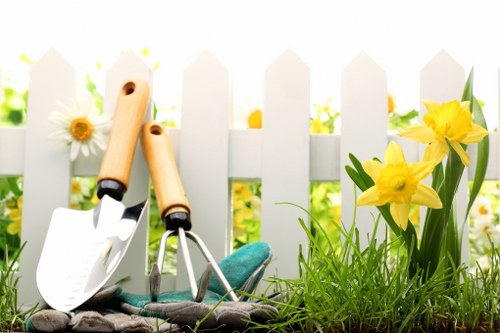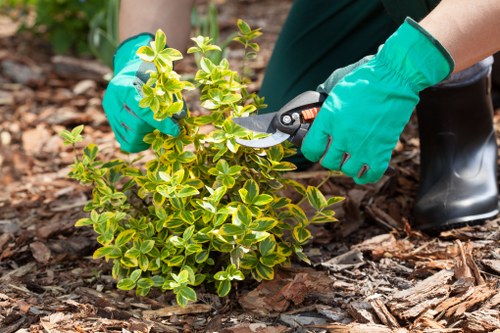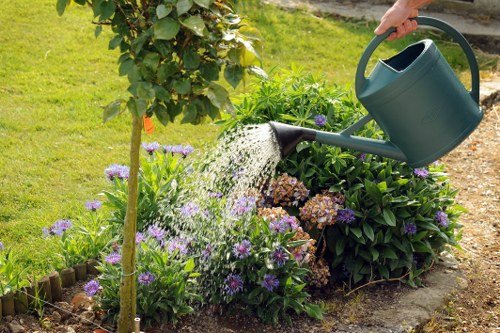Lawn Turf Installation in Grass Cutting: Transform Your Outdoor Space

Introduction to Lawn Turf Installation
Transforming your outdoor space begins with a lush, green lawn that not only enhances the aesthetic appeal of your property but also provides a relaxing environment for outdoor activities. Lawn turf installation is a popular choice for homeowners seeking an immediate, vibrant lawn without the wait associated with seed-based methods.
Grass cutting plays a crucial role in maintaining the health and appearance of your turf-installed lawn. Regular mowing encourages dense growth, prevents weed proliferation, and keeps your lawn looking pristine throughout the seasons.

Benefits of Lawn Turf Installation
Opting for turf installation offers numerous advantages over traditional seeding methods. Here are some key benefits:
- Instant Beauty: Enjoy a perfectly manicured lawn immediately after installation.
- Durability: Turf is more resilient to heavy foot traffic, making it ideal for active households.
- Low Maintenance: Requires less time and effort to maintain compared to waiting for seeds to germinate and grow.
- Weed Control: Pre-grown turf minimizes the presence of weeds, ensuring a cleaner lawn.
With these benefits, turf installation stands out as a superior option for those seeking a hassle-free and attractive lawn.

Choosing the Right Type of Turf
Selecting the appropriate type of turf is essential for achieving the desired look and functionality of your lawn. Here are some popular turf varieties:
- Bermuda Grass: Ideal for warm climates, known for its durability and fine texture.
- Fescue Grass: Suited for cooler regions, offering excellent shade tolerance and lush green color.
- Kentucky Bluegrass: Favored for its rich color and ability to recover from wear, perfect for residential lawns.
- Zoysia Grass: A versatile option that thrives in both sun and shade, providing a dense and carpet-like appearance.
Consider your local climate, soil type, and lawn usage when selecting the turf variety to ensure optimal growth and longevity.

Preparing Your Lawn for Turf Installation
Proper preparation is key to successful turf installation. Follow these steps to ensure a smooth and effective process:
- Soil Testing: Assess your soil’s pH and nutrient levels to determine if any amendments are needed.
- Clearing the Area: Remove existing grass, weeds, rocks, and debris to create a clean slate for turf laying.
- Grading and Leveling: Ensure the ground is level to prevent water pooling and promote even growth.
- Soil Conditioning: Incorporate compost or topsoil to improve soil structure and fertility.
Taking these preparatory steps will lay the foundation for a healthy, vibrant lawn that stands the test of time.

Step-by-Step Turf Installation Process
Follow this comprehensive guide to install your lawn turf efficiently:
1. Planning and Measuring
Begin by measuring the area where you intend to lay the turf. Accurate measurements ensure you purchase the right amount of turf and minimize waste.
2. Soil Preparation
As mentioned earlier, prepare the soil by clearing, grading, and conditioning to create an optimal environment for turf growth.
3. Laying the Turf
Start laying the turf along a straight edge, such as a driveway or walkway. Place each roll tightly against the previous one to avoid gaps and ensure a seamless appearance.
4. Seaming and Trimming
Carefully trim the edges using a sharp knife or utility tool to fit the turf around obstacles and maintain a neat border.
5. Watering and Initial Care
Water the newly installed turf thoroughly to help the roots establish. Maintain consistent moisture levels during the first few weeks to encourage strong growth.
Maintenance Tips for Turf-Installed Lawns
Maintaining a turf-installed lawn involves specific practices to ensure its longevity and beauty:
- Regular Grass Cutting: Mow your lawn regularly to the recommended height for your turf type. This promotes dense growth and prevents weed invasion.
- Watering: Even though turf requires less water than seeded lawns, ensure adequate hydration, especially during dry spells.
- Fertilization: Apply fertilizers as needed to replenish nutrients and support healthy grass growth.
- Aeration: Periodically aerate the soil to improve oxygen flow and reduce compaction.
Consistent maintenance will keep your turf-installed lawn vibrant and resilient against environmental stresses.

Common Challenges and Solutions
While turf installation is generally straightforward, certain challenges may arise. Here are common issues and their solutions:
1. Turf Slippage
Ensure that turf is laid tightly against adjacent rolls and secured properly to prevent shifting. Proper soil preparation also reduces the risk of slippage.
2. Weed Growth
Use a pre-emergent herbicide before laying the turf and maintain regular mowing to inhibit weed establishment.
3. Uneven Growth
Aerate and fertilize the lawn regularly to promote uniform growth and address any nutrient deficiencies.

Cost Considerations for Turf Installation
The cost of turf installation can vary based on several factors. Here’s what to consider:
- Turf Type: Premium varieties may cost more but offer superior durability and appearance.
- Area Size: Larger lawns require more turf and labor, increasing overall costs.
- Soil Preparation: Extensive preparation work can add to the expenses.
- Labor: Professional installation ensures quality but may involve higher upfront costs compared to DIY methods.
Budgeting for turf installation involves assessing these factors to determine the most cost-effective approach without compromising quality.

Environmental Impact of Turf Installation
Choosing turf for your lawn can have both positive and negative environmental implications:
- Positive: Turf reduces soil erosion, provides habitat for beneficial insects, and can help lower urban heat island effects.
- Negative: Synthetic turf alternatives may contribute to microplastic pollution, whereas natural turf requires water and maintenance.
Opting for sustainable turf options and mindful maintenance practices can mitigate negative impacts and enhance the environmental benefits of your lawn.

Integrating Smart Technologies in Lawn Care
Modern advancements offer innovative solutions for maintaining turf-installed lawns efficiently:
- Smart Irrigation Systems: Utilize sensors and weather data to optimize watering schedules, conserving water and promoting healthy growth.
- Robotic Lawn Mowers: Automate grass cutting, ensuring consistent maintenance with minimal effort.
- Soil Sensors: Monitor soil health in real-time, allowing for precise fertilization and care.
Incorporating these technologies can enhance the upkeep of your lawn, making maintenance more manageable and environmentally friendly.

Professional vs. DIY Turf Installation
Deciding between hiring professionals and undertaking a DIY turf installation depends on several factors:
Advantages of Professional Installation
- Expertise: Professionals bring experience and knowledge, ensuring optimal installation techniques.
- Time Efficiency: Saves you significant time and effort, especially for large or complex lawns.
- Quality Assurance: Guarantees a high-quality finish with lasting results.
Benefits of DIY Turf Installation
- Cost Savings: Eliminates labor costs associated with hiring professionals.
- Personal Satisfaction: Offers a sense of accomplishment and control over the process.
- Flexibility: Allows you to work at your own pace and schedule.
Weigh the pros and cons based on your budget, skills, and the size of your project to make an informed decision.
Choosing the Right Grass Cutting Schedule
Establishing an appropriate grass cutting schedule is vital for maintaining the health and appearance of your turf-installed lawn:
- Frequency: Generally, mow once a week during the growing season, adjusting frequency based on growth rates.
- Height: Maintain the recommended mowing height for your specific turf type to encourage strong root development.
- Sharp Blades: Ensure mower blades are sharp to make clean cuts, reducing stress on the grass.
- Clippings: Consider mulching the clippings to return nutrients to the soil, promoting healthier growth.
Adhering to a consistent grass cutting routine enhances the overall vigor and visual appeal of your lawn.

Seasonal Lawn Care Tips
Different seasons require varying care approaches to maintain a healthy turf-installed lawn:
Spring
- Clean-Up: Remove debris and thatch buildup from winter.
- Fertilization: Apply a balanced fertilizer to support new growth.
- Aeration: Aerate the soil to enhance nutrient and water penetration.
Summer
- Watering: Water deeply but infrequently to encourage deep root systems.
- Mowing: Raise mowing height to provide shade and reduce evaporation.
- Pest Control: Monitor for pests and apply treatments as necessary.
Autumn
- Overseeding: Fill in bare spots to prepare for winter.
- Fertilization: Use a winterizing fertilizer to strengthen roots.
- Leaf Removal: Keep the lawn free of fallen leaves to prevent suffocation.
Winter
- Minimize Traffic: Reduce foot traffic to prevent turf damage.
- Snow Removal: Clear snow gently to avoid tearing up the turf.
- Equipment Maintenance: Service lawn care tools for the upcoming season.

Enhancing Your Lawn with Landscaping Features
Complement your turf-installed lawn with various landscaping elements to create a harmonious outdoor space:
- Flower Beds: Add color and diversity with seasonal blooms around your lawn.
- Pathways: Define walkways with stone, gravel, or pavers for both functionality and style.
- Water Features: Incorporate fountains or ponds to introduce soothing sounds and visual interest.
- Lighting: Use landscape lighting to highlight features and extend outdoor enjoyment into the evening.
Integrating these features not only enhances the beauty of your lawn but also increases the overall value of your property.

Sustainable Practices for Lawn Care
Adopting sustainable lawn care practices benefits both your environment and your lawn's health:
- Organic Fertilizers: Use natural fertilizers to reduce chemical runoff and improve soil health.
- Native Grass Varieties: Choose grass types native to your region for better adaptability and lower maintenance.
- Rainwater Harvesting: Collect and utilize rainwater for irrigation to conserve water resources.
- Integrated Pest Management: Employ eco-friendly pest control methods to minimize environmental impact.
Implementing these sustainable methods fosters a healthier ecosystem and ensures the long-term viability of your lawn.

The Role of Grass Cutting in Preventing Lawn Diseases
Proper grass cutting is instrumental in preventing and managing lawn diseases:
- Reduces Stress: Regular mowing minimizes plant stress, making grass less susceptible to diseases.
- Improves Airflow: Trimming grass allows better air circulation, reducing the likelihood of fungal growth.
- Prevents Overgrowth: Keeping grass at recommended heights discourages weed invasion and disease spread.
By maintaining an appropriate grass cutting regimen, you safeguard your lawn against common ailments and ensure its enduring health.

Final Thoughts on Turf Installation and Grass Cutting
Lawn turf installation combined with consistent grass cutting forms the cornerstone of a beautiful and healthy outdoor space. By understanding the benefits, selecting the right turf, preparing your lawn meticulously, and adhering to a regular maintenance schedule, you can achieve a lush, resilient lawn that enhances your property's appeal and provides a serene environment for you and your family.
Embrace the transformation that turf installation offers and invest in proper grass cutting practices to enjoy a pristine lawn year-round.
Contact us today to schedule your turf installation and take the first step towards a stunning lawn.

